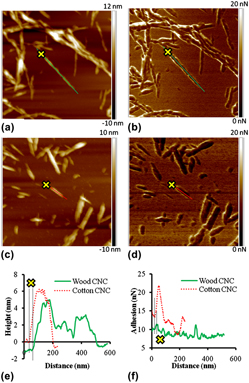Crossref Citations
This article has been cited by the following publications. This list is generated based on data provided by
Crossref.
Leung, Alfred C. W.
Lam, Edmond
Chong, Jonathan
Hrapovic, Sabahudin
and
Luong, John H. T.
2013.
Reinforced plastics and aerogels by nanocrystalline cellulose.
Journal of Nanoparticle Research,
Vol. 15,
Issue. 5,
Wu, Xiawa
Moon, Robert J.
and
Martini, Ashlie
2013.
Crystalline cellulose elastic modulus predicted by atomistic models of uniform deformation and nanoscale indentation.
Cellulose,
Vol. 20,
Issue. 1,
p.
43.
Ago, Mariko
Jakes, Joseph E.
and
Rojas, Orlando J.
2013.
Thermomechanical Properties of Lignin-Based Electrospun Nanofibers and Films Reinforced with Cellulose Nanocrystals: A Dynamic Mechanical and Nanoindentation Study.
ACS Applied Materials & Interfaces,
Vol. 5,
Issue. 22,
p.
11768.
Camacho, Jorge
Gronski, Kjerstin
Flaig, Robinson
Wu, Yan
and
Hamilton, James P.
2013.
Nanomechanical characterization of graphene platelets in polypropylene-based graphene nanocomposites using atomic force microscopy.
p.
808.
Wu, Qiang
Meng, Yujie
Concha, Katherine
Wang, Siqun
Li, Yanjun
Ma, Lingfei
and
Fu, Shenyun
2013.
Influence of temperature and humidity on nano-mechanical properties of cellulose nanocrystal films made from switchgrass and cotton.
Industrial Crops and Products,
Vol. 48,
Issue. ,
p.
28.
Dri, Fernando L.
Hector, Louis G.
Moon, Robert J.
and
Zavattieri, Pablo D.
2013.
Anisotropy of the elastic properties of crystalline cellulose Iβ from first principles density functional theory with Van der Waals interactions.
Cellulose,
Vol. 20,
Issue. 6,
p.
2703.
Guo, Dan
Xie, Guoxin
and
Luo, Jianbin
2014.
Mechanical properties of nanoparticles: basics and applications.
Journal of Physics D: Applied Physics,
Vol. 47,
Issue. 1,
p.
013001.
Dri, Fernando L
Shang, ShunLi
Hector, Louis G
Saxe, Paul
Liu, Zi-Kui
Moon, Robert J
and
Zavattieri, Pablo D
2014.
Anisotropy and temperature dependence of structural, thermodynamic, and elastic properties of crystalline cellulose Iβ: a first-principles investigation.
Modelling and Simulation in Materials Science and Engineering,
Vol. 22,
Issue. 8,
p.
085012.
IOELOVICH, MICHAEL
2014.
Peculiarities of cellulose nanoparticles.
TAPPI Journal,
Vol. 13,
Issue. 5,
p.
45.
Wu, Xiawa
Moon, Robert J.
and
Martini, Ashlie
2014.
Tensile strength of Iβ crystalline cellulose predicted by molecular dynamics simulation.
Cellulose,
Vol. 21,
Issue. 4,
p.
2233.
Hu, Fei
Fu, Shiyu
Huang, Jin
Anderson, Debbie P.
and
Chang, Peter R.
2015.
Polysaccharide‐Based Nanocrystals.
p.
15.
Chen, Longjian
Li, Aiwei
He, Xueqin
and
Han, Lujia
2015.
A multi-scale biomechanical model based on the physiological structure and lignocellulose components of wheat straw.
Carbohydrate Polymers,
Vol. 133,
Issue. ,
p.
135.
Ma, Piming
Jiang, Long
Hoch, Martin
Dong, Weifu
and
Chen, Mingqing
2015.
Reinforcement of transparent ethylene-co-vinyl acetate rubber by nanocrystalline cellulose.
European Polymer Journal,
Vol. 66,
Issue. ,
p.
47.
Soeta, Hiroto
Fujisawa, Shuji
Saito, Tsuguyuki
Berglund, Lars
and
Isogai, Akira
2015.
Low-Birefringent and Highly Tough Nanocellulose-Reinforced Cellulose Triacetate.
ACS Applied Materials & Interfaces,
Vol. 7,
Issue. 20,
p.
11041.
Amiralian, Nasim
Annamalai, Pratheep K.
Memmott, Paul
Taran, Elena
Schmidt, Susanne
and
Martin, Darren J.
2015.
Easily deconstructed, high aspect ratio cellulose nanofibres from Triodia pungens; an abundant grass of Australia's arid zone.
RSC Advances,
Vol. 5,
Issue. 41,
p.
32124.
Huang, Jun
and
Rodrigue, Denis
2015.
Comparison of the mechanical properties between carbon nanotube and nanocrystalline cellulose polypropylene based nano-composites.
Materials & Design (1980-2015),
Vol. 65,
Issue. ,
p.
974.
Miao, Xiaran
Tian, Feng
Lin, Jinyou
Li, Hui
Li, Xiuhong
Bian, Fenggang
and
Zhang, Xiangzhi
2016.
Tuning the mechanical properties of cellulose nanofibrils reinforced polyvinyl alcohol composites via altering the cellulose polymorphs.
RSC Advances,
Vol. 6,
Issue. 86,
p.
83356.
Wagner, Ryan
Moon, Robert J.
and
Raman, Arvind
2016.
Mechanical properties of cellulose nanomaterials studied by contact resonance atomic force microscopy.
Cellulose,
Vol. 23,
Issue. 2,
p.
1031.
Ioelovich, Michael
2016.
Fabrication and Self-Assembly of Nanobiomaterials.
p.
243.
Kargarzadeh, Hanieh
Ioelovich, Michael
Ahmad, Ishak
Thomas, Sabu
and
Dufresne, Alain
2017.
Handbook of Nanocellulose and Cellulose Nanocomposites.
p.
1.



